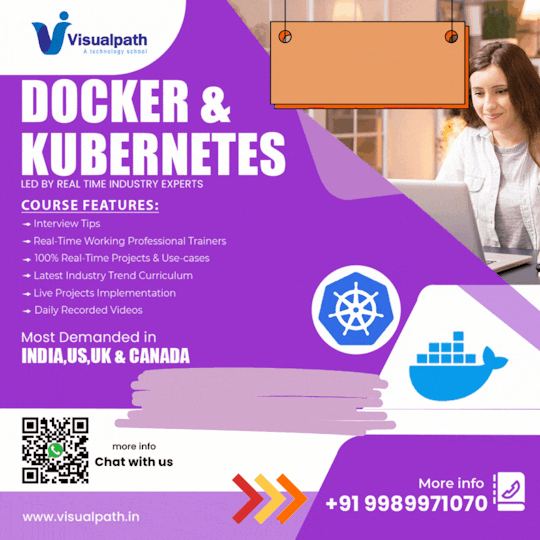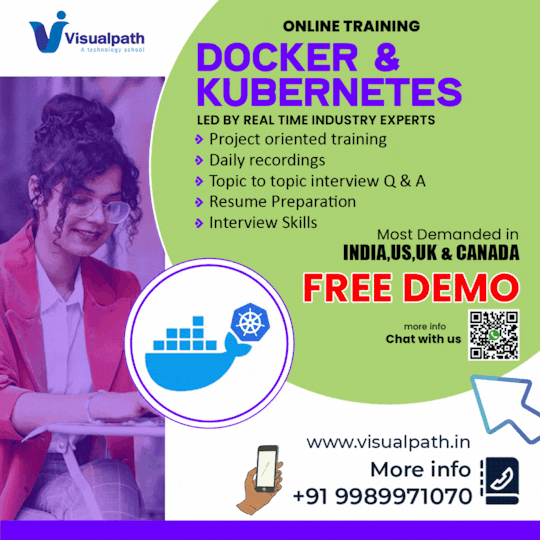#KubernetesTrainingHyderabad
Explore tagged Tumblr posts
Text
Kubernetes Online Training Certification
The Key Components of Kubernetes: Control Plane and Compute Plane
Introduction:
Kubernetes has emerged as the leading platform for container orchestration, enabling organizations to efficiently deploy, scale, and manage containerized applications. At the heart of Kubernetes architecture lie two fundamental components: the Control Plane and the Compute Plane.
The Control Plane:
The Control Plane, also known as the Master Node, serves as the brain of the Kubernetes cluster, responsible for managing and coordinating all activities within the cluster. - Docker and Kubernetes Training
It comprises several key components, each playing a distinct role in ensuring the smooth operation of the cluster:
API Server: The API Server acts as the front-end for the Kubernetes control plane. It exposes the Kubernetes API, which allows users to interact with the cluster, define workloads, and query the cluster's state. All management operations, such as creating, updating, or deleting resources, are handled through the API Server.
Scheduler: The Scheduler component is responsible for assigning workloads to individual nodes within the cluster based on resource availability, constraints, and other policies. It ensures that workload placement is optimized for performance, reliability, and resource utilization, taking into account factors such as affinity, anti-affinity, and resource requirements. - Docker Online Training
Controller Manager: The Controller Manager is a collection of controllers that continuously monitor the cluster's state and drive the cluster towards the desired state defined by the user. These controllers handle various tasks, such as managing replication controllers, ensuring the desired number of pod replicas are running, handling node failures, and maintaining overall cluster health.
etcd: etcd is a distributed key-value store used by Kubernetes to store all cluster data, including configuration settings, state information, and metadata. It provides a reliable and highly available storage solution, ensuring that critical cluster data is persisted even in the event of node failures or network partitions. - Kubernetes Online Training
The Compute Plane:
While the Control Plane manages the orchestration and coordination aspects of the cluster, the Compute Plane, also known as the Worker Node, is responsible for executing and running containerized workloads.
It consists of the following key components:
Kubelet: The Kubelet is an agent that runs on each Worker Node and is responsible for managing the node's containers and ensuring they are in the desired state. It communicates with the Control Plane to receive instructions, pull container images, start/stop containers, and report the node's status.
Container Runtime: The Container Runtime is responsible for running and managing containers on the Worker Node. Kubernetes supports various container runtimes, including Docker, containerd, and cri-o, allowing users to choose the runtime that best fits their requirements. - CKA Training Online
Kube Proxy: Kube Proxy is a network proxy that runs on each Worker Node and facilitates network communication between services within the Kubernetes cluster. It maintains network rules and performs packet forwarding, ensuring that services can discover and communicate with each other seamlessly.
Conclusion:
In conclusion, the Control Plane and Compute Plane are two fundamental components of the Kubernetes architecture, working in tandem to orchestrate and manage containerized workloads efficiently.
Visualpath is the Leading and Best Institute for learning Docker And Kubernetes Online in Ameerpet, Hyderabad. We provide Docker Online Training Course, you will get the best course at an affordable cost.
Attend Free Demo
Call on - +91-9989971070.
Visit : https://www.visualpath.in/DevOps-docker-kubernetes-training.html
WhatsApp : https://www.whatsapp.com/catalog/919989971070/
#KubernetesTrainingHyderabad#DockerandKubernetesTraining#KubernetesOnlineTraining#DockerOnlineTraining#DockerTraininginHyderabad#DockerandKubernetesOnlineTraining#KubernetesTraininginAmeerpet
0 notes
Text

Kubernetes Certification Online Training
Visualpath provides the best Kubernetes CKA Online Training classes by real-time faculty with real-time Projects. We are providing Kubernetes Certification Training Course Demanded in the USA, UK, Canada, India, and Australia. Call on +91-9989971070.
WhatsApp: https://bit.ly/47eayBz
Visit: https://www.visualpath.in/DevOps-docker-kubernetes-training.html
#KubernetesTrainingHyderabad#DockerandKubernetesTraining#KubernetesOnlineTraining#DockerOnlineTraining#DockerTraininginHyderabad#DockerandKubernetesOnlineTraining#DockerOnlineTrainingHyderabad
0 notes
Text
Docker Online Training Hyderabad | Visualpath
Kubernetes Authentication and Authorization
Introduction:
Kubernetes authentication and authorization mechanisms play a critical role in safeguarding clusters against unauthorized access and protecting sensitive workloads and data. - Docker and Kubernetes Training
Authentication in Kubernetes:
Authentication is the process of verifying the identity of users or entities attempting to access a Kubernetes cluster. Kubernetes supports various authentication methods, each catering to different use cases and deployment scenarios:
Client Certificates: Kubernetes can authenticate users based on client certificates signed by a trusted Certificate Authority (CA). This method is commonly used in production environments, where users authenticate using X.509 client certificates issued by the cluster's CA. - Kubernetes Online Training
Static Tokens: Kubernetes allows administrators to create static bearer tokens associated with specific users or service accounts. While convenient for testing and development, static tokens pose security risks if not managed properly and are not recommended for production use.
Service Account Tokens: Kubernetes automatically creates service accounts for pods running within the cluster. Service account tokens, mounted as secrets within pods, enable applications to authenticate with the Kubernetes API server and access cluster resources.
External Identity Providers: Kubernetes can integrate with external identity providers (e.g., LDAP, OAuth, OpenID Connect) for user authentication. This approach enables centralized identity management and single sign-on (SSO) capabilities across multiple Kubernetes clusters. - Docker Online Training
Implementing Authorization Policies:
Authorization, also known as access control, determines the actions users or entities are allowed to perform within a Kubernetes cluster. Kubernetes employs Role-Based Access Control (RBAC) as its primary authorization mechanism, allowing administrators to define granular access policies based on roles and role bindings:
Roles: A role defines a set of permissions (e.g., create, read, update, delete) for a specific set of resources within a Kubernetes namespace. Roles are scoped to a namespace and can be created using YAML manifest files.
Role Bindings: Role bindings associate roles with users, groups, or service accounts, granting them the permissions defined by the corresponding roles. Kubernetes supports both RoleBindings (for assigning roles within a namespace) and ClusterRoleBindings (for assigning roles across the entire cluster). - Kubernetes Training Hyderabad
Cluster Roles: In addition to namespace-scoped roles, Kubernetes supports cluster-wide roles called ClusterRoles. ClusterRoles enable administrators to define global access policies that apply across all namespaces within the cluster.
Best Practices for Kubernetes Authentication and Authorization:
Implement RBAC: Utilize Kubernetes RBAC to define fine-grained access controls based on the principle of least privilege. Regularly review and audit role definitions and role bindings to ensure they align with security policies and least privilege principles.
Leverage Service Accounts: Use Kubernetes service accounts to authenticate and authorize applications and workloads running within the cluster. Avoid using static bearer tokens or overly permissive access controls for service accounts. - Docker and Kubernetes Online Training
Enable Network Policies: Implement Kubernetes Network Policies to control traffic flow between pods and enforce network segmentation. Network policies augment RBAC by restricting network communication based on pod labels, namespaces, and other attributes.
Integrate with Identity Providers: Integrate Kubernetes with external identity providers to enable centralized authentication and SSO across multiple clusters. Leverage standard protocols like OAuth and OpenID Connect for seamless integration with existing identity management systems.
Regularly Rotate Secrets: Rotate client certificates, bearer tokens, and other authentication credentials regularly to mitigate the risk of unauthorized access due to compromised credentials or expired certificates.
Conclusion:
Authentication and authorization are foundational pillars of Kubernetes security, ensuring that only authorized users and workloads can access and interact with cluster resources.
Visualpath is the Leading and Best Institute for learning Docker And Kubernetes Online in Ameerpet, Hyderabad. We provide Docker Online Training Course, you will get the best course at an affordable cost.
Attend Free Demo
Call on - +91-9989971070.
Visit : https://www.visualpath.in/DevOps-docker-kubernetes-training.html
WhatsApp : https://www.whatsapp.com/catalog/919989971070/
#KubernetesTrainingHyderabad#KubernetesOnlineTraining#DockerandKubernetesTraining#DockerOnlineTraining#DockerTraininginHyderabad#DockerandKubernetesOnlineTraining#KubernetesTraininginAmeerpet
0 notes
Text

Kubernetes Online Training Hyderabad
Visualpath provides the best Kubernetes Online Training classes by real-time faculty with real-time Projects. We are providing Docker and Kubernetes Training Demanded in the USA, UK, Canada, India, and Australia. Call on +91-9989971070.
WhatsApp: https://bit.ly/47eayBz
Visit: https://www.visualpath.in/DevOps-docker-kubernetes-training.html
#KubernetesTrainingHyderabad#DockerandKubernetesTraining#KubernetesOnlineTraining#DockerOnlineTraining#DockerTraininginHyderabad#DockerandKubernetesOnlineTraining#KubernetesOnlineTrainingHyderabad
0 notes
Text
Kubernetes Online Training | India
Docker Containers and Images: Comprehensive Guide
Introduction:
Docker containers and images have emerged as essential technologies. They have revolutionized the way applications are built, shipped, and run across various computing environments. - Docker and Kubernetes Training
What are Containers?
Containers are lightweight, standalone, and executable packages that contain everything needed to run a piece of software, including the code, runtime, libraries, and dependencies. They encapsulate an application and its environment, ensuring consistency and portability across different platforms. Unlike traditional virtual machines, which require a separate operating system instance for each application, containers share the host system's kernel while maintaining isolation from one another. - Kubernetes Online Training
Containers provide several benefits, including:
Portability: Containers can run consistently across various environments, including development, testing, staging, and production, without modification, thanks to their self-contained nature.
Efficiency: Containers consume fewer resources compared to virtual machines, as they share the host system's kernel and avoid the overhead of running multiple operating system instances. - Docker Online Training
Isolation: Each container operates independently of others, ensuring that applications remain isolated and do not interfere with one another's execution.
Scalability: Containers are highly scalable, allowing developers to easily scale applications up or down based on demand by orchestrating containerized workloads with tools like Kubernetes or Docker Swarm.
What are Images?
Images serve as the building blocks for containers. They are read-only templates that contain the application's code, dependencies, runtime environment, and other configuration files needed to create a container instance.
Key characteristics of images include:
Immutability: Images are immutable, meaning they cannot be changed once they are created. Any modifications to an image result in the creation of a new image layer, preserving the integrity and reproducibility of the original image.
Docker and Kubernetes Online Training
Layered Architecture: Images are composed of multiple layers, each representing a specific component or configuration. This layered architecture enables efficient storage, distribution, and caching of image components.
Versioning: Images can be versioned to track changes and updates over time. Versioning allows developers to roll back to previous versions if needed and facilitates collaboration and reproducibility in software development workflows.
Conclusion:
In conclusion, containers and images play a pivotal role in modern software development and deployment practices. They offer a lightweight, portable, and efficient means of packaging, distributing, and running applications across diverse computing environments.
Visualpath is the Leading and Best Institute for learning Docker And Kubernetes Online in Ameerpet, Hyderabad. We provide Docker Online Training Course, you will get the best course at an affordable cost.
Attend Free Demo
Call on - +91-9989971070.
Visit : https://www.visualpath.in/DevOps-docker-kubernetes-training.html
WhatsApp : https://www.whatsapp.com/catalog/919989971070/
#KubernetesTrainingHyderabad#DockerandKubernetesTraining#KubernetesOnlineTraining#DockerOnlineTraining#DockerTraininginHyderabad#DockerandKubernetesOnlineTraining#DockerOnlineTrainingHyderabad
0 notes